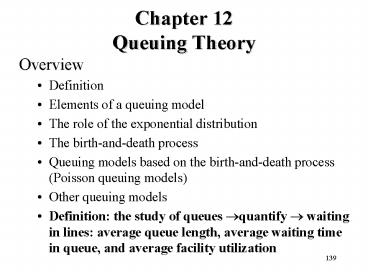Chapter 12 Queuing Theory PowerPoint PPT Presentation
1 / 16
Title: Chapter 12 Queuing Theory
1
Chapter 12 Queuing Theory
- Overview
- Definition
- Elements of a queuing model
- The role of the exponential distribution
- The birth-and-death process
- Queuing models based on the birth-and-death
process (Poisson queuing models) - Other queuing models
- Definition the study of queues ?quantify ?
waiting in lines average queue length, average
waiting time in queue, and average facility
utilization
2
Elements of a Queuing Model
- Description Customer(s) ?arrive?Server(s)
choose (FIFO, LIFO, etc.)?leave - Elements of a queuing model
- Arrival distribution
- Service time distribution
- Design of service facility
- Service discipline
- Customer population (size of the queue and
customer population - Human behavior
3
Elements of a Queuing Model
- Output information (under steady-state
condition) - Ls expected number of customers in the system
- Lq expected queuing length
- Ws expected waiting time in system
- Wq expected waiting time in the queue
- Input information (a/b/c), (d/e/f)
- a arrival distribution
- b service time distribution
- c number of parallel servers
- d service discipline
- e maximum number allowed in the system
- f size of customer population
4
Role of Exponential Distribution
- Random interarrival and service times are
described quantitatively in queuing models by the
exponential distribution - In most queuing situations, the arrival of
customers occurs in a totally random exponential
distribution is completely random - The exponential distribution has the
forgetfulness or lack of memory
5
The Birth-and-Death Process
- Pure Birth Model
- Arrivals only are allowed
- The interarrival time is exponential with mean
1/? - Result the number of arrivals during a specific
T is Poisson with mean ?T
6
The Birth-and-Death Process
- Pure Death Model
- Departures only are permitted. At time 0 N
customers - The interdeparture time is exponential with mean
1/µ - Result the probability pn(t) of n customers
remaining after t time units is a truncated
Poisson distribution
7
Queuing Models Based on the Birth-and-Death
Process Poisson Queuing Models
- Poisson Assumptions The interarrival and service
time exponential distribution - Generalized Poisson Queuing Model
- Assumption arrival and departure rates are state
dependent - Given ?n, µn arrival and departure rate if n
customers in the system - Determine pn steady-state probability of n
customers in the system - Solution
- Setup the transition rate diagram
- Solve the system of balance equations and unity
condition of probability
8
Poisson Queuing Models Single Server System
- ? arrival rate of jobs per unit time, ?n
? ? service rate of jobs per unit time (if
serving facility is kept busy), ?n ? - (M/M/1)(GD/?/?) the steady state results
- Ws 1/(? -?)
- Wq ?/?(1 - ?) where ? ?/? traffic
intensity - Lq ?Wq ?2/(1- ?)
- Assumption ? lt1 finite queue
9
Example
- Automata car wash facility operates with only
one bay. Cars arrive according to a Poisson
distribution with a mean of 4 cars per hour and
may wait in the facilitys parking lot if the bay
is busy. The time for washing and cleaning a car
is exponential, with a mean of 10 minutes. Cars
that cannot park in the lot can wait in the
street bordering the wash facility. This means
that for all practical purposes, there is no
limit on the size of the system. The manager of
the facility wants to determine the size of the
parking lot
10
Poisson Queuing Models
- Multiple servers systems
- Use formulae
- Use tables and charts to obtain queuing
statistics
11
Poisson Queuing Models Multiple Servers Systems
- (M/M/c)(GD/?/?). If c servers have an
exponential distribution with service rate ? and
arrival rate ?. if we let ? ?/? lt 1 then we
have - where p0 is the probability of zero customers
in the queue,
12
Example
- A community is served by two cab companies. Each
company owns two cabs, and the two companies are
known to have equal shares of market. This is
evident by the fact that calls arrive at each
companys dispatching office at the rate of 8 per
hour. The average time per ride is 12 minutes.
Calls arrive according to a Poisson distribution,
and the ride time is exponential distribution.
The two companies recently were bought by an
investor who is interested in consolidating them
into a single dispatching office to provide
better service to customers. Analyze the new
owners proposal
13
Poisson Queuing Models Self-Service Model
- (M/M/?)(GD/N/?)
?n ? µn nµ
14
Poisson Queuing Models Machine Servicing Model
- (M/M/R)(GD/K/K), R K find a value of R
repairmen (servers) for K machines that minimizes
the total expected costs, which consist of the
cost of failure and the cost of service. If ? is
the rate of breakdown per machine and there are n
broken machines, given the arrival rate - and the service rate is
- Pn is the probability of n
machines in the system. The steady-state results
Where expected number of idle repairmen
15
Example
- Toolco operates a machine shop with a total of
22 machines. Each machine is known to break down
once every 2 hours, on the average. It takes an
average of 12 minutes to complete a repair. Both
the time between breakdowns and the repair time
follow the exponential distribution. Toolco is
interested in determining the number of repair
persons needed to keep the shop running smoothly
16
Other Queuing Models
- Extension of Poison queuing models
- Non-Poison queuing models
- Queuing network
- Priority-Discipline queuing models
- Queuing Decision Models

